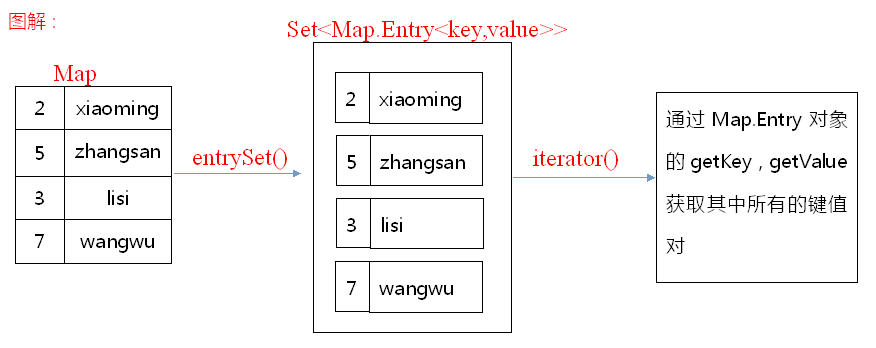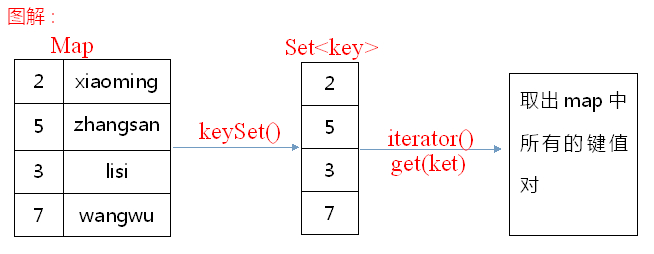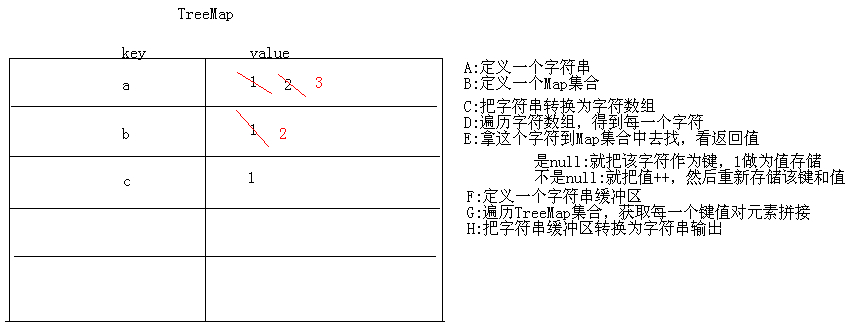18.01 Map集合概述和特点
Map接口概述:将键映射到值的对象,一个映射不能包含重复的键,每个键最多只能映射到一个值
Map接口和Collection接口的不同
1.Map是双列的,Collection是单列的
2.Map的键唯一,Collection的子体系Set是唯一的
3.Map集合的数据结构值针对键有效,跟值无关,Collection集合的数据结构是针对元素有效
18.02 Map集合的功能概述
成员方法:
将指定的值与此映射中的指定键关联(可选操作)。
如果存在一个键的映射关系,则将其从此映射中移除(可选操作)。
3.void clear():
从此映射中移除所有映射关系(可选操作)。
4.boolean containsKey(Object key):
如果此映射包含指定键的映射关系,则返回 true。
5.boolean containsValue(Object value):
如果此映射将一个或多个键映射到指定值,则返回 true。
6.boolean isEmpty():
如果此映射未包含键-值映射关系,则返回 true。
7.int size():
返回此映射中的键-值映射关系数。
返回指定键所映射的值;如果此映射不包含该键的映射关系,则返回 null。
返回此映射中包含的键的 Set 视图。
10.Collection<V> values()
返回此映射中包含的值的 Collection 视图。
11.Set<Map.Entry<K,V>> entrySet()
返回此映射中包含的映射关系的 Set 视图。
18.03 Map集合的基本功能测试
map.put("001", "旺财"); :第一次存储直接存储元素,返回null
map.put("001", "小强"); :不是第一次存储,用新值将以前的值替换掉,返回以前的值
map.remove("001"); :根据键删除键值对元素,并返回键所对应的值,没有则返回空
18.04 Map集合的获取功能测试
1 Map<String, String> map = new HashMap<String, String>(); 2 3 map.put("001", "小明"); 4 map.put("002", "旺财"); 5 map.put("003", "小强"); 6 //根据键获取值 7 System.out.println(map.get("002"));//旺财,没有该键返回null 8 System.out.println("-----"); 9 //获取集合中所有键的集合 10 Set<String> set = map.keySet(); 11 for(String key : set) 12 { 13 System.out.println(key); 14 } 15 System.out.println("-----"); 16 //获取集合中所有值的集合 17 Collection<String> coll = map.values(); 18 for(String value : coll) 19 { 20 System.out.println(value); 21 }
18.05 Map集合的遍历之键找值
根据键找值:
获取所有键的集合,遍历键的集合,获取到每一个键,根据键找值
1 Map<String, String> map = new HashMap<String, String>(); 2 map.put("001", "小明"); 3 map.put("002", "旺财"); 4 map.put("003", "小强"); 5 6 //获取所有的键 7 Set<String> set = map.keySet(); 8 for(String key : set) 9 { 10 //根据键找值 11 String value = map.get(key); 12 System.out.println(key+":"+value); 13 }
18.06 Map集合的遍历之键值对对象找键和值
根据键值对对象找键和值:
获取所有键值对对象的集合,遍历键值对对象的集合,获取到每一个键值对对象,根据键值对对象找键和值
1 Map<String, String> map = new HashMap<String, String>(); 2 map.put("001", "小明"); 3 map.put("002", "旺财"); 4 map.put("003", "小强"); 5 //获取所有键值对对象的集合 6 Set<Map.Entry<String, String>> set = map.entrySet(); 7 //遍历键值对对象的集合,获取每一个键值对对象 8 for(Map.Entry<String, String> me : set) 9 { 10 //根据键值对对象获取键和值 11 String key = me.getKey(); 12 String value = me.getValue(); 13 System.out.println(key+":"+value); 14 }
18.07 Map集合遍历的两种方式比较图解


18.08 HashMap集合键是Stirng值是String的案例
HashMap类概述:键是哈希表结构,可以保证键的唯一性
1 HashMap<String, String> map = new HashMap<String, String>(); 2 3 map.put("001", "小明"); 4 map.put("002", "旺财"); 5 map.put("003", "小强"); 6 map.put("004", "小红"); 7 Set<String> set = map.keySet(); 8 for(String key : set) 9 { 10 String value = map.get(key); 11 System.out.println(key+"--"+value); 12 }
18.09 HashMap集合键是Student值是String的案例
1 // 创建集合对象 2 HashMap<Student, String> hm = new HashMap<Student, String>(); 3 4 hm.put(new Student("小明",23), "001"); 5 hm.put(new Student("小强",15), "002"); 6 hm.put(new Student("旺财",13), "003"); 7 hm.put(new Student("张三",17), "004"); 8 hm.put(new Student("小强",15), "005"); 9 10 // 遍历 11 Set<Student> set = hm.keySet(); 12 for (Student key : set) 13 { 14 String value = hm.get(key); 15 System.out.println(key.getName() + "---" + key.getAge() + "---" 16 + value); 17 }
当键是自定义对象时,需重写hashCode()和equals()方法
18.10 LinkedHashMap的概述和使用
Map接口的哈希表和链接列表实现,具有可预知的迭代顺序。
由哈希表保证键的唯一性
由链表保证键的有序
1 LinkedHashMap<String, String> hm = new LinkedHashMap<String,String>(); 2 3 // 创建并添加元素 4 hm.put("2345", "hello"); 5 hm.put("1234", "world"); 6 hm.put("3456", "java"); 7 hm.put("1234", "javaee"); 8 hm.put("3456", "android"); 9 10 // 遍历 11 Set<String> set = hm.keySet(); 12 for (String key : set) 13 { 14 String value = hm.get(key); 15 System.out.println(key + "---" + value); 16 }
运行结果:
2345---hello 1234---javaee 3456---android
18.11 TreeMap集合键是String值是String的案例
TreeMap类概述:键是红黑树结构,可以保证键的排序和唯一性
1 // 创建集合对象 2 TreeMap<String, String> tm = new TreeMap<String, String>(); 3 4 // 创建元素并添加元素 5 tm.put("hello", "你好"); 6 tm.put("world", "世界"); 7 tm.put("java", "爪哇"); 8 tm.put("world", "世界2"); 9 tm.put("javaee", "爪哇EE"); 10 11 // 遍历集合 12 Set<String> set = tm.keySet(); 13 for (String key : set) 14 { 15 String value = tm.get(key); 16 System.out.println(key + "---" + value); 17 }
运行结果:
hello---你好 java---爪哇 javaee---爪哇EE world---世界2
18.12 TreeMap集合键是Student值是String的案例
1 public class Practice 2 { 3 public static void main(String[] args) 4 { 5 // 创建集合对象 6 TreeMap<Student, String> tm = new TreeMap<Student, String>(new Comparator<Student>() 7 { 8 @Override 9 public int compare(Student s1, Student s2) 10 { 11 // 主要条件 12 int num = s1.getAge() - s2.getAge(); 13 // 次要条件 14 int num2 = num == 0 ? s1.getName().compareTo( 15 s2.getName()) : num; 16 return num2; 17 } 18 }); 19 20 tm.put(new Student("小明",23), "001"); 21 tm.put(new Student("小强",15), "002"); 22 tm.put(new Student("旺财",13), "003"); 23 tm.put(new Student("张三",17), "004"); 24 tm.put(new Student("小强",15), "005"); 25 26 Set<Map.Entry<Student, String>> set = tm.entrySet(); 27 for(Map.Entry<Student, String> me : set) 28 { 29 Student key = me.getKey(); 30 String value = me.getValue(); 31 System.out.println(key.getName()+":"+key.getAge()+":"+value); 32 } 33 } 34 }
运行结果:
旺财:13:003 小强:15:005 张三:17:004 小明:23:001
18.13 统计字符串中每个字符出现的次数案例图解
"aababcabcdabcde",获取字符串中每一个字母出现的次数要求结果:a(5)b(4)c(3)d(2)e(1)

18.14 统计字符串中每个字符出现的次数案例代码实现
1 public class Practice 2 { 3 public static void main(String[] args) 4 { 5 // 定义一个字符串(改进为键盘录入) 6 Scanner sc = new Scanner(System.in); 7 System.out.println("请输入一个字符串:"); 8 String line = sc.nextLine(); 9 10 // 定义一个TreeMap集合 11 TreeMap<Character, Integer> tm = new TreeMap<Character, Integer>(); 12 13 //把字符串转换为字符数组 14 char[] chs = line.toCharArray(); 15 16 //遍历字符数组,得到每一个字符 17 for(char ch : chs) 18 { 19 //拿刚才得到的字符作为键到集合中去找值,看返回值 20 Integer i = tm.get(ch); 21 22 //是null:说明该键不存在,就把该字符作为键,1作为值存储 23 if(i == null) 24 { 25 tm.put(ch, 1); 26 } 27 else 28 { 29 //不是null:说明该键存在,就把值加1,然后重写存储该键和值 30 i++; 31 tm.put(ch,i); 32 } 33 } 34 35 //定义字符串缓冲区变量 36 StringBuilder sb= new StringBuilder(); 37 38 //遍历集合,得到键和值,进行按照要求拼接 39 Set<Character> set = tm.keySet(); 40 for(Character key : set) 41 { 42 Integer value = tm.get(key); 43 sb.append(key).append("(").append(value).append(")"); 44 } 45 46 //把字符串缓冲区转换为字符串输出 47 String result = sb.toString(); 48 System.out.println("结果:"+result); 49 } 50 }
运行结果:
请输入一个字符串:
aasdgrfedcsdf
结果:a(2)c(1)d(3)e(1)f(2)g(1)r(1)s(2)
18.15 HashMap集合嵌套HashMap集合的案例
1 public class Practice 2 { 3 public static void main(String[] args) 4 { 5 // 大集合对象 6 HashMap<String, HashMap<String, Integer>> bigMap = new HashMap<String, HashMap<String, Integer>>(); 7 8 // 集合对象1 9 HashMap<String, Integer> hm1 = new HashMap<String, Integer>(); 10 // 添加元素 11 hm1.put("小明", 20); 12 hm1.put("小强", 22); 13 // 把集合添加到大集合 14 bigMap.put("集合1", hm1); 15 16 // 集合对象2 17 HashMap<String, Integer> hm2 = new HashMap<String, Integer>(); 18 // 添加元素 19 hm2.put("旺财", 5); 20 hm2.put("张三", 23); 21 // 把集合添加到大集合 22 bigMap.put("集合2", hm2); 23 24 //遍历集合 25 Set<String> bigMapset = bigMap.keySet(); 26 for(String bigMapKey : bigMapset) 27 { 28 System.out.println(bigMapKey); 29 HashMap<String, Integer> value = bigMap.get(bigMapKey); 30 Set<String> set = value.keySet(); 31 for(String s : set) 32 { 33 Integer i = value.get(s); 34 System.out.println(" "+s+":"+i); 35 } 36 } 37 } 38 }
运行结果:
集合1 小强:22 小明:20 集合2 旺财:5 张三:23
18.16 集合多层嵌套的代码体现
1 public class Practice 2 { 3 public static void main(String[] args) 4 { 5 // 创建大集合 6 HashMap<String, HashMap<String, ArrayList<Student>>> czbkMap = new HashMap<String, HashMap<String, ArrayList<Student>>>(); 7 8 // 北京校区数据 9 HashMap<String, ArrayList<Student>> bjCzbkMap = new HashMap<String, ArrayList<Student>>(); 10 ArrayList<Student> array1 = new ArrayList<Student>(); 11 Student s1 = new Student("林青霞", 27); 12 Student s2 = new Student("风清扬", 30); 13 array1.add(s1); 14 array1.add(s2); 15 ArrayList<Student> array2 = new ArrayList<Student>(); 16 Student s3 = new Student("赵雅芝", 28); 17 Student s4 = new Student("武鑫", 29); 18 array2.add(s3); 19 array2.add(s4); 20 bjCzbkMap.put("基础班", array1); 21 bjCzbkMap.put("就业班", array2); 22 czbkMap.put("北京校区", bjCzbkMap); 23 24 // 西安校区数据 25 HashMap<String, ArrayList<Student>> xaCzbkMap = new HashMap<String, ArrayList<Student>>(); 26 ArrayList<Student> array3 = new ArrayList<Student>(); 27 Student s5 = new Student("范冰冰", 27); 28 Student s6 = new Student("刘意", 30); 29 array3.add(s5); 30 array3.add(s6); 31 ArrayList<Student> array4 = new ArrayList<Student>(); 32 Student s7 = new Student("李冰冰", 28); 33 Student s8 = new Student("张志豪", 29); 34 array4.add(s7); 35 array4.add(s8); 36 xaCzbkMap.put("基础班", array3); 37 xaCzbkMap.put("就业班", array4); 38 czbkMap.put("西安校区", xaCzbkMap); 39 40 // 遍历集合 41 Set<String> czbkMapSet = czbkMap.keySet(); 42 for (String czbkMapKey : czbkMapSet) 43 { 44 System.out.println(czbkMapKey); 45 HashMap<String, ArrayList<Student>> czbkMapValue = czbkMap.get(czbkMapKey); 46 Set<String> czbkMapValueSet = czbkMapValue.keySet(); 47 for (String czbkMapValueKey : czbkMapValueSet) 48 { 49 System.out.println(" " + czbkMapValueKey); 50 ArrayList<Student> czbkMapValueValue = czbkMapValue.get(czbkMapValueKey); 51 for (Student s : czbkMapValueValue) 52 { 53 System.out.println(" " + s.getName() + "---"+ s.getAge()); 54 } 55 } 56 } 57 } 58 }
运行结果:
北京校区 就业班 赵雅芝---28 武鑫---29 基础班 林青霞---27 风清扬---30 西安校区 就业班 李冰冰---28 张志豪---29 基础班 范冰冰---27 刘意---30
18.17 HashMap和Hashtable的区别
1:Hashtable和HashMap的区别
Hashtable:线程安全,效率低。不允许null键和null值
HashMap:线程不安全,效率高。允许null键和null值
2:List,Set,Map等接口是否都继承子Map接口?
List,Set不是继承自Map接口,它们继承自Collection接口
Map接口本身就是一个顶层接口
18.18 Collections工具类的概述
Collections类概述:针对集合操作的工具类,都是静态方法
Collection和Collections的区别:
Collection:是单列集合的顶层接口,有子接口List和Set。
Collections:是针对集合操作的工具类,有对集合进行排序和二分查找的方法
18.19 Collections工具类的常见方法讲解
Collections成员方法
1.public static <T extends Comparable<? super T>> void sort(List<T> list):
根据元素的自然顺序对指定列表按升序进行排序。
2.public static <T> int binarySearch(List<? extends Comparable<? super T>> list,T key):
使用二分搜索法搜索指定列表,以获得指定对象。
3.public static <T extends Object & Comparable<? super T>> T max(Collection<? extends T> coll):
根据元素的自然顺序,返回给定 collection 的最大元素。
4.public static void reverse(List<?> list):
反转指定列表中元素的顺序。
5.public static void shuffle(List<?> list):
使用默认随机源对指定列表进行置换。所有置换发生的可能性都是大致相等的。
例:
1 public class Practice 2 { 3 public static void main(String[] args) 4 { 5 // 创建集合对象 6 List<Integer> list = new ArrayList<Integer>(); 7 8 // 添加元素 9 list.add(30); 10 list.add(20); 11 list.add(50); 12 list.add(10); 13 list.add(40); 14 15 System.out.println("原始:" + list); 16 //排序 默认情况下是自然顺序 17 Collections.sort(list); 18 System.out.println("排序:" + list); 19 // 二分查找 20 System.out.println("查找:"+Collections.binarySearch(list, 30)); 21 // 最大值 22 System.out.println("最大值:"+Collections.max(list)); 23 // 反转 24 Collections.reverse(list); 25 System.out.println("反转:" + list); 26 //随机置换 27 Collections.shuffle(list); 28 System.out.println("随机:" + list); 29 } 30 }
运行结果:
原始:[30, 20, 50, 10, 40] 排序:[10, 20, 30, 40, 50] 查找:2 最大值:50 反转:[50, 40, 30, 20, 10] 随机:[20, 10, 30, 50, 40]
18.20 ArrayList存储自定义对象并排序案例
1 public class Practice 2 { 3 public static void main(String[] args) 4 { 5 // 创建集合对象 6 List<Student> list = new ArrayList<Student>(); 7 8 // 创建学生对象 9 Student s1 = new Student("小明", 27); 10 Student s2 = new Student("旺财", 30); 11 Student s3 = new Student("小强", 28); 12 Student s4 = new Student("张三", 29); 13 14 // 添加元素对象 15 list.add(s1); 16 list.add(s2); 17 list.add(s3); 18 list.add(s4); 19 20 // 排序 21 // 自然排序必须实现 Comparable 接口 22 //Collections.sort(list); 23 // 比较器排序 24 // 如果同时有自然排序和比较器排序,以比较器排序为主 25 Collections.sort(list, new Comparator<Student>() 26 { 27 @Override 28 public int compare(Student s1, Student s2) 29 { 30 int num = s2.getAge() - s1.getAge(); 31 int num2 = num == 0 ? s1.getName().compareTo(s2.getName()): num; 32 return num2; 33 } 34 }); 35 // 遍历集合 36 for (Student s : list) 37 { 38 System.out.println(s.getName() + "---" + s.getAge()); 39 } 40 } 41 }
运行结果:
旺财---30 张三---29 小强---28 小明---27
18.21 模拟斗地主洗牌和发牌
模拟斗地主洗牌和发牌
分析:
A:创建一个牌盒、B:装牌、C:洗牌、D:发牌、E:看牌
1 public class Practice 2 { 3 public static void main(String[] args) 4 { 5 // 创建一个牌盒 6 ArrayList<String> array = new ArrayList<String>(); 7 8 // 定义一个花色数组 9 String[] colors = { "♠", "♥", "♣", "♦" }; 10 // 定义一个点数数组 11 String[] numbers = { "A", "2", "3", "4", "5", "6", "7", "8", "9", "10", 12 "J", "Q", "K" }; 13 // 装牌 14 for (String color : colors) 15 { 16 for (String number : numbers) 17 { 18 array.add(color.concat(number)); 19 } 20 } 21 array.add("小王"); 22 array.add("大王"); 23 24 // 洗牌 25 Collections.shuffle(array); 26 27 // System.out.println("array:" + array); 28 29 // 发牌 30 ArrayList<String> player1 = new ArrayList<String>(); 31 ArrayList<String> player2 = new ArrayList<String>(); 32 ArrayList<String> player3 = new ArrayList<String>(); 33 ArrayList<String> diPai = new ArrayList<String>(); 34 35 for (int x = 0; x < array.size(); x++) 36 { 37 if (x >= array.size() - 3) 38 { 39 diPai.add(array.get(x)); 40 } 41 else if (x % 3 == 0) 42 { 43 player1.add(array.get(x)); 44 } 45 else if (x % 3 == 1) 46 { 47 player2.add(array.get(x)); 48 } 49 else if (x % 3 == 2) 50 { 51 player3.add(array.get(x)); 52 } 53 } 54 55 // 看牌 56 lookPoker("玩家1", player1); 57 lookPoker("玩家2", player2); 58 lookPoker("玩家3", player3); 59 60 lookPoker("底牌", diPai); 61 } 62 63 public static void lookPoker(String name, ArrayList<String> array) 64 { 65 System.out.print(name + "的牌是:"); 66 for (String s : array) 67 { 68 System.out.print(s + " "); 69 } 70 System.out.println(); 71 } 72 }
运行结果:
玩家1的牌是:♦10 ♥4 ♠K ♠5 ♦6 ♥K ♦8 ♥2 ♥3 ♣8 ♣3 ♣4 ♦7 ♠Q ♣10 ♠3 ♠6 玩家2的牌是:♦9 ♦5 ♦A ♣5 ♦3 ♥8 ♣2 ♥J ♦J ♥5 ♦4 ♠9 ♠10 小王♣A ♥Q ♥7 玩家3的牌是:♠A ♣6 ♦2 ♦K ♣9 ♣K ♣7 ♦Q ♠4 ♥9 ♠7 大王♣Q ♥10 ♠8 ♣J ♠2 底牌的牌是:♥A ♥6 ♠J
18.22 模拟斗地主洗牌和发牌并对牌进行排序的代码实现
思路:
A:创建一个HashMap集合
B:创建一个ArrayList集合
C:创建花色数组和点数数组
D:从0开始往HashMap里面存储编号,并存储对应的牌,同时往ArrayList里面存储编号即可。
E:洗牌(洗的是编号)
F:发牌(发的也是编号,为了保证编号是排序的,就创建TreeSet集合接收)
G:看牌(遍历TreeSet集合,获取编号,到HashMap集合找对应的牌)
1 public class Practice 2 { 3 public static void main(String[] args) 4 { 5 // 创建一个HashMap集合 6 HashMap<Integer, String> hm = new HashMap<Integer, String>(); 7 8 // 创建一个ArrayList集合 9 ArrayList<Integer> array = new ArrayList<Integer>(); 10 11 // 创建花色数组和点数数组 12 // 定义一个花色数组 13 String[] colors = { "♠", "♥", "♣", "♦" }; 14 // 定义一个点数数组 15 String[] numbers = { "3", "4", "5", "6", "7", "8", "9", "10", "J", "Q", 16 "K", "A", "2", }; 17 18 // 从0开始往HashMap里面存储编号,并存储对应的牌,同时往ArrayList里面存储编号即可。 19 int index = 0; 20 21 for (String number : numbers) 22 { 23 for (String color : colors) 24 { 25 String poker = color.concat(number); 26 hm.put(index, poker); 27 array.add(index); 28 index++; 29 } 30 } 31 hm.put(index, "小王"); 32 array.add(index); 33 index++; 34 hm.put(index, "大王"); 35 array.add(index); 36 37 // 洗牌(洗的是编号) 38 Collections.shuffle(array); 39 40 // 发牌(发的也是编号,为了保证编号是排序的,就创建TreeSet集合接收) 41 TreeSet<Integer> player1 = new TreeSet<Integer>(); 42 TreeSet<Integer> player2 = new TreeSet<Integer>(); 43 TreeSet<Integer> player3 = new TreeSet<Integer>(); 44 TreeSet<Integer> diPai = new TreeSet<Integer>(); 45 46 for (int x = 0; x < array.size(); x++) 47 { 48 if (x >= array.size() - 3) 49 { 50 diPai.add(array.get(x)); 51 } else if (x % 3 == 0) 52 { 53 player1.add(array.get(x)); 54 } else if (x % 3 == 1) 55 { 56 player2.add(array.get(x)); 57 } else if (x % 3 == 2) 58 { 59 player3.add(array.get(x)); 60 } 61 } 62 63 // 看牌(遍历TreeSet集合,获取编号,到HashMap集合找对应的牌) 64 lookPoker("玩家1", player1, hm); 65 lookPoker("玩家2", player2, hm); 66 lookPoker("玩家3", player3, hm); 67 lookPoker("底牌", diPai, hm); 68 } 69 70 // 写看牌的功能 71 public static void lookPoker(String name, TreeSet<Integer> ts, 72 HashMap<Integer, String> hm) 73 { 74 System.out.print(name + "的牌是:"); 75 for (Integer key : ts) 76 { 77 String value = hm.get(key); 78 System.out.print(value + " "); 79 } 80 System.out.println(); 81 } 82 }
运行结果:
玩家1的牌是:♠3 ♦3 ♥4 ♣4 ♥5 ♣5 ♠6 ♣8 ♥9 ♦10 ♥J ♣J ♦Q ♣A ♠2 ♣2 大王 玩家2的牌是:♠5 ♦5 ♣7 ♦7 ♠9 ♥10 ♦J ♠Q ♣Q ♠K ♣K ♠A ♥A ♦A ♥2 ♦2 小王 玩家3的牌是:♥3 ♣3 ♠4 ♦4 ♥6 ♣6 ♠7 ♥7 ♥8 ♦8 ♣9 ♠10 ♣10 ♠J ♥Q ♥K ♦K 底牌的牌是:♦6 ♠8 ♦9